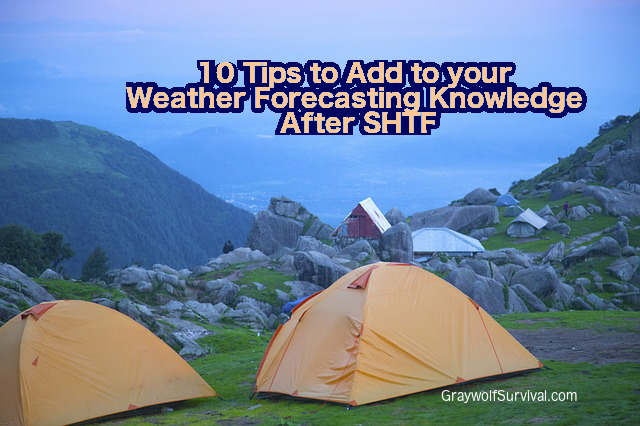 (Guest Post) Learning how to predict the weather without relying on forecasts is an essential skill that a survivalist or prepper should develop. In general, a lot of people depend on a forecast to determine the kind of weather they are going to expect on a certain day. However, note that there are ways for you to predict the weather just by observing and increasing your knowledge about weather patterns.
(Guest Post) Learning how to predict the weather without relying on forecasts is an essential skill that a survivalist or prepper should develop. In general, a lot of people depend on a forecast to determine the kind of weather they are going to expect on a certain day. However, note that there are ways for you to predict the weather just by observing and increasing your knowledge about weather patterns.
Knowing how to predict the weather is not only fun and exciting. It is also a useful survival skill, especially if you love outdoor activities, like camping and hiking. It is also a big help for your survival after SHTF or an emergency. All it takes is to learn what to look for to predict the weather naturally without the need for any technological device or forecast.
To help increase your knowledge about weather predictions, here are ten valuable tips that you can add to your weather forecasting knowledge after SHTF:
1. Observe the clouds.
Predicting the weather after SHTF is possible by checking and observing the clouds. Note that the kinds and shapes of clouds present in the sky can give you an idea about the upcoming weather. It is also advisable to check their movement and direction. In most cases, white and high clouds often indicate good weather. Meanwhile, low and dark clouds indicate that there is going to be rain or storm soon.
As for the direction and movement of the clouds, what you need to watch out for is whether they are moving apart or coming together. One sign that there is impending bad weather is if the clouds are lowering and gathering together. If they are spreading out and rising then there is a great chance for the weather to clear out.
The color of the cloud can also tell you what the weather is going to be. Note that clouds appear in various shades, including brown, black, gray, and white. Each color tells you something about the weather. If the clouds come in shades of black then a storm might come without strong winds.
Brown clouds, on the other hand, can tell you that the upcoming storm will be accompanied by strong winds. White clouds signal good weather, although there is still a chance for a storm to come later in the day. Clouds may also have shades of gray, indicating an upcoming light or new storm. The gray shade also means that a storm is affecting a huge area and has the tendency of staying for quite a while.
2. Check the sky.
Find out if the sky is red in the morning. Note that the movement of the weather is naturally from the West to the East. The sun, on the other hand, rises in the East while the sunset is on the West. If the sky is red upon the time you check it in the morning then this signals clear weather in the direction of the sunrise (the East). However, the West might be experiencing extremely bad weather, causing redness in the sky.
This bad weather might move towards you based on the way weather patterns naturally work. The kind of shade that the sky might display in that scenario is bold orange or deep red. If the shades of red appear in the sky during the evening then you can have peace of mind as this indicates that the skies in the West are clear and they will be coming to you. The bad weather will move to the East away from you.
3. Detect air pressure
While air pressure is not as noticeable as the clouds, many survivalists and outdoor adventure enthusiasts consider it as a reliable indicator of the upcoming weather conditions. One thing to take note of is that low-atmospheric pressures can result in the formation of clouds and precipitation. On the other hand, high-pressure systems can be linked to clear dry skies and rising air.
A viable tip when trying to detect the present air pressure is to analyze and observe the smoke coming from a campfire. A smoke that steadily rises in a vertical column can instantly tell you that there is high water pressure. However, if the smoke tends to swirl and sink then it indicates low air pressure, which might lead to precipitation right after.
4. Read the wind
Knowing how to read the wind is also the key to forecasting or predicting the weather after SHTF without the need for actual tools and devices. One thing to remember, in this case, is that the name of the wind is taken from the specific direction it travels from. This means that an Easterly wind indicates that it was blown from the East to the West.
When it comes to reading the wind, note that a prevailing and gentle wind, as well as a variable and light wind, signals clear weather. There is a chance for strong winds to appear in case two fronts having various temperatures meet. In such a case, the strong winds can tell you that there is an upcoming storm.
Being aware of the climate surrounding you is also the key in accurately reading the wind. For example, if there is a desert found at the east of your present location, then the Eastern wind might carry warm and dry desert air. The presence of the mountains also contributes a lot when trying to determine the weather through the wind.
It is because the air that flows over the mountains often release precipitation every time it rises on the side that faces the wind. It then moves down to the opposite direction, bringing dry air.
5. Observe the moon
You can also predict the weather by observing the moon. Find out if there is a visible ring surrounding the moon or sun. If there is then this results from the ice crystals in the cirrus clouds that tend to refract the light coming from the celestial bodies. In general, cirrus clouds signal the coming of foul or bad weather, so if you see the ring, then it may also be the perfect time for you to begin waterproofing. If the moon is bright and clear without any obstructions then you can be sure that you will experience clear weather the coming day.
6. Count and observe the stars
Do you feel like there is an upcoming storm? Then you may want to observe and count the stars to confirm your intuition. If you find over ten stars then your gut feeling that there will be an upcoming storm may come true, although it will only be light. However, if you see fewer than ten stars then it is greatly possible for the storm to be heavy. Lack of stars indicates excessive cloud coverage coming from the approaching weather. It is highly likely for your place to experience clear skies if you can see plenty of stars.
7. Observe the behaviors of birds
Some of the behavioral patterns of animals, like birds, can also give some sort of information about the weather. One of the things you have to look out for about birds is any form of migration. Note that birds have the ability to sense air pressure. With that ability, they will schedule bird migrations during the time when the weather is good. That said, look for flocks of birds that migrate in the sky if you want to search for a sign that the entire day will be good.
Another thing to observe about birds is their eating pattern. During a storm, try to find out if birds eat. A short storm will most likely happen if most birds wait for the rainy days to stop before they start looking for food again. However, if most birds eat during stormy weather, then it is greatly possible for this weather to last longer than expected. The ability of birds to sense the patterns of air pressure is one reason why they can effectively predict the weather.
8. Watch out for snakes
One thing you have to know about snakes is that they tend to get out of their nests before bad weather strikes. They do that even during the middle of winter. One sign of upcoming bad weather is if you see snakes at a time when they should be in their nest or if they become visible in unanticipated places. Snakes are even capable of predicting earthquakes. If there is a snake who tends to behave erratically in its nest then it is highly likely for an earthquake to come.
During sunny weather, you can see snakes out of their nests because they want to warm themselves. However, if snakes tend to move out of their nest even if the weather is not hot then this indicates upcoming bad weather.
9. Observe the behaviors of cows
If there are cows in your vicinity then you can use their behavioral patterns to predict the weather. In most cases, cows lie down once they sense that there will be an upcoming thunderstorm. You will often find these cows grouping themselves together during upcoming bad weather.
10. Use a weather stick
Another method of forecasting the weather the natural way is to utilize a weather stick. This could be in the form of a balsam fir tree, which you can turn into an effective and simple natural barometer. What you have to do is to let a branch dry. Make sure to leave a bit of its trunk close to the base. The next thing to do is to peel the bark. Use a nail to hang this weather stick, ensuring that the branch hangs naturally.
This weather stick tends to work similarly to a campfire’s smoke. It responds to nice weather or high pressure by moving upward sharply. In case of a low air pressure, which could indicate an upcoming rain, the weather stick will most likely move downwards.
Conclusion
Increasing your weather forecasting knowledge is not that hard. During and after SHTF, you can just watch out for the natural elements and patterns in your surroundings to predict the weather and act appropriately.
Check out GeekPrepper.com for more information if you liked this article.












thanks
Very useful information.